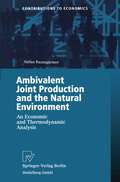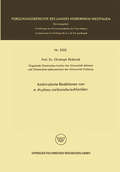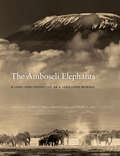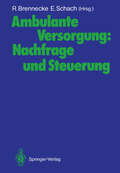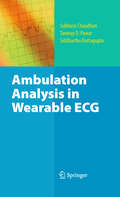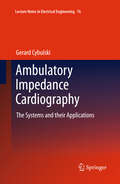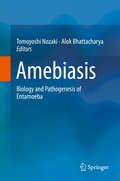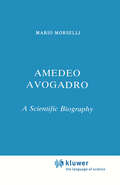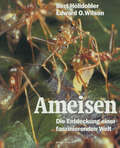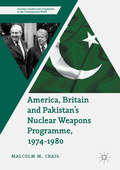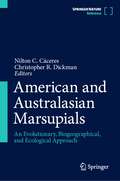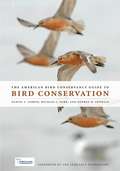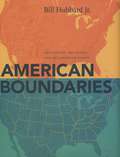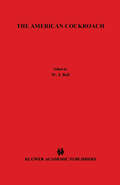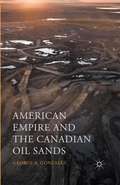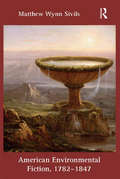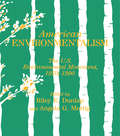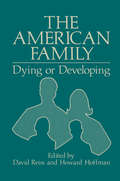- Table View
- List View
Ambivalent Joint Production and the Natural Environment: An Economic and Thermodynamic Analysis (Contributions to Economics)
by Stefan BaumgärtnerMany environmental damages are caused by substances which come into existence as undesired joint outputs in the production of desired goods. Whether an output is desired or not, however, is not an inherent property of the substance itself but depends on the context of production. This book studies in an interdisciplinary way the role of the potential ambivalence of joint outputs for the description and analysis of dynamic economy-environment interactions and for the design of environmental policy.
Ambivalente Reaktionen von α-Acyloxy-Carbonsäurechloriden (Forschungsberichte des Landes Nordrhein-Westfalen)
by Prof. Dr. RüchardtThe Amboseli Elephants: A Long-Term Perspective on a Long-Lived Mammal
by Cynthia J. MossElephants have fascinated humans for millennia. Aristotle wrote of them with awe; Hannibal used them in warfare; and John Donne called the elephant “Nature’s greatest masterpiece. . . . The only harmless great thing.” Their ivory has been sought after and treasured in most cultures, and they have delighted zoo and circus audiences worldwide for centuries. But it wasn’t until the second half of the twentieth century that people started to take an interest in elephants in the wild, and some of the most important studies of these intelligent giants have been conducted at Amboseli National Park in Kenya. The Amboseli Elephants is the long-awaited summation of what’s been learned from the Amboseli Elephant Research Project (AERP)—the longest continuously running elephant research project in the world. Cynthia J. Moss and Harvey Croze, the founders of the AERP, and Phyllis C. Lee, who has been closely involved with the project since 1982, compile more than three decades of uninterrupted study of over 2,500 individual elephants, from newborn calves to adult bulls to old matriarchs in their 60s. Chapters explore such topics as elephant ecosystems, genetics, communication, social behavior, and reproduction, as well as exciting new developments from the study of elephant minds and cognition. The book closes with a view to the future, making important arguments for the ethical treatment of elephants and suggestions to aid in their conservation. The most comprehensive account of elephants in their natural environment to date, The Amboseli Elephants will be an invaluable resource for scientists, conservationists, and anyone interested in the lives and loves of these extraordinary creatures.
The Amboseli Elephants: A Long-Term Perspective on a Long-Lived Mammal
by Cynthia J. Moss Harvey Croze Phyllis C. LeeElephants have fascinated humans for millennia. Aristotle wrote of them with awe; Hannibal used them in warfare; and John Donne called the elephant “Nature’s greatest masterpiece. . . . The only harmless great thing.” Their ivory has been sought after and treasured in most cultures, and they have delighted zoo and circus audiences worldwide for centuries. But it wasn’t until the second half of the twentieth century that people started to take an interest in elephants in the wild, and some of the most important studies of these intelligent giants have been conducted at Amboseli National Park in Kenya. The Amboseli Elephants is the long-awaited summation of what’s been learned from the Amboseli Elephant Research Project (AERP)—the longest continuously running elephant research project in the world. Cynthia J. Moss and Harvey Croze, the founders of the AERP, and Phyllis C. Lee, who has been closely involved with the project since 1982, compile more than three decades of uninterrupted study of over 2,500 individual elephants, from newborn calves to adult bulls to old matriarchs in their 60s. Chapters explore such topics as elephant ecosystems, genetics, communication, social behavior, and reproduction, as well as exciting new developments from the study of elephant minds and cognition. The book closes with a view to the future, making important arguments for the ethical treatment of elephants and suggestions to aid in their conservation. The most comprehensive account of elephants in their natural environment to date, The Amboseli Elephants will be an invaluable resource for scientists, conservationists, and anyone interested in the lives and loves of these extraordinary creatures.
Ambulante Versorgung: Nachfrage und Steuerung
by Ralph Brennecke Elisabeth SchachMitglieder der Arbeitsgruppe Gesundheitsökonomie der Deutschen Gesellschaft für Sozialmedizin behandeln in diesem Buch Fragen zur Nachfrage und zur Steuerung in der ambulanten Versorgung. Vorwiegend empirisch werden in Beiträgen aus der Bundesrepublik und der Schweiz ökonomische und medizinische Analysen vorgestellt: - zur Anreizgestaltung in der ambulanten Versorgung durch das Vergütungssystem, - zu Veränderungen des Wahlverhaltens in der Selbstverwaltung, - zu Möglichkeiten der Substitution stationärer durch ambulante Versorgung, - zu Determinanten der Nachfrage nach ambulanten Leistungen, - zu Behandlungsunterschieden und - zu notwendigen Ergänzungen der ambulanten Versorgung.
Ambulation Analysis in Wearable ECG
by Subhasis Chaudhuri Tanmay D. Pawar Siddhartha DuttaguptaAmbulation Analysis in Wearable ECG demonstrates why, due to recent developments, the wearable ECG recorder substantiates a significant innovation in the healthcare field. About this book: Examines the viability of wearable ECG in cardiac monitoring Includes chapters written by practitioners who have personally developed such hardware to write about the hardware details Bridges the gap between hardware and algorithmic developments with chapters that specifically discuss the hardware aspects and their corresponding calibration issues Presents a useful text for both practitioners and researchers in biomedical engineering and related interdisciplinary fields Assumes basic familiarity with digital signal processing and linear algebra.
Ambulatory Impedance Cardiography: The Systems and their Applications (Lecture Notes in Electrical Engineering #76)
by Gerard CybulskiThe book is divided in 4 parts. In the first one, the importance of the analysis of the cardiac dynamics using the ambulatory monitoring technique is presented. The second part contains the description of foundations of impedance cardiography (ICG), the models used to describe the ICG technique and the description of available systems for ambulatory monitoring of cardiac hemodynamics. The third part is devoted to the validation of the ambulatory ICG method, the verification of the quality of long term ICG recordings and the discussion of the limitations of this technique. In the last part, some clinical and research applications of the ICG ambulatory monitoring are presented. The simultaneous recordings of electrocardiogram (ECG) and ICG in the transient cardiac arrhythmia events illustrate the potential applications of that method for quantitative analysis of hemodynamics when the implementation of the stationary methods would be either difficult or not possible to do. The book is followed by references, alphabetical index and appendices containing the technical data of the available systems for portable monitoring of cardiac hemodynamics.
Amebiasis: Biology and Pathogenesis of Entamoeba
by Tomoyoshi Nozaki Alok BhattacharyaThis book documents and presents new developments in the study of amebiasis, one of the neglected tropical diseases. Nearly 50 million people worldwide are infected with the pathogen Entamoeba histolytica, causing large-scale morbidity and mortality particularly in developing countries. This book will help clinicians for better diagnosis and management of the disease, researchers for initiating research projects on some of the poorly understood aspects of the disease and the pathogen, and students for updating their knowledge. The subjects covered range from genomics and molecular and cell biology to drug resistance and new drug development, highlighting major advances in recent years in our understanding due to rapid progress in genomic and other biomedical technologies, such as visualization of molecular processes. Most of the chapters provide recent information based on latest publications. A few chapters describe some of the critical methodological issues that will be helpful for students and researchers interested in getting into the field. The contributing authors include almost all the active researchers and clinicians from around the world. This book will be a useful primary material and a valuable source of information for anyone interested in understanding amebiasis, its diagnosis, and treatment. It will also be useful to those who are interested in learning about the biology of early branching eukaryotes and protist pathogens.
Amedeo Avogadro: A Scientific Biography (Chemists and Chemistry #1)
by M. MorselliQuantum refert in quae tempora vel optimi cujusque virtus incidet. (From an architrave on the Palatine.) The history of the development of scientific thought offers several examples of unconventional, perplexing and untimely conjectures advanced by obscure men. The molecular hypothesis set forth by Amedeo Avogadro in 1811 is one of these. It was little noticed when proposed and it soon fell into oblivion. Although numerous attempts have been made in the past one hundred years to identify the main reasons for the neglect and the indifference which surrounded the molecular hypothesis, very little effort has been devoted to showing how historical circumstances and Avogadro's own personality hindered the acceptance of the concepts he had proposed. After half a century of intense scientific activity, Avogadro passed away as little known in Italy as abroad. He had few close friends and his personal life seemed centered on his large family and his work. Outside this limited circle, he avoided social engagements and intellectual contacts. This attitude may have been encouraged by the political situation in Piedmont, his native country, which remained essentially hostile to intellectual activity until 1840, by which time Avogadro was sixty-four. The only respite in Piedmont had come during the short-lived Napoleonic regime; and quite remarkably, the molecular hypothesis was conceived and published at the very end of this period.
America, Britain and Pakistan’s Nuclear Weapons Programme, 1974-1980: A Dream of Nightmare Proportions
by Malcolm M. CraigThis book analyses US and UK efforts to shut down Pakistan’s nuclear programme in the 1970s, between the catalytic Indian nuclear test of May 1974 and the decline of sustained non-proliferation activity from mid-1979 onwards. It is a tale of cooperation between Washington and London, but also a story of divisions and disputes. The brutal economic realities of the decade, globalisation, and wider geopolitical challenges all complicated this relationship. Policy and action were also affected by changes elsewhere in the world. Iran’s 1979 revolution brought a new form of political Islamic radicalism to prominence. The fears engendered by the Ayatollah and his followers, coupled to the blustering rhetoric of Pakistani leaders, gave rise to the ‘Islamic bomb’, a nuclear weapon supposedly created by Pakistan to be shared amongst the Muslim ummah. This study thus combines cultural, diplomatic, economic, and political history to offer a rigorous, deeply researched account of a critical moment in nuclear history.
America, Britain and Pakistan’s Nuclear Weapons Programme, 1974-1980: A Dream of Nightmare Proportions
by Malcolm M. CraigThis book analyses US and UK efforts to shut down Pakistan’s nuclear programme in the 1970s, between the catalytic Indian nuclear test of May 1974 and the decline of sustained non-proliferation activity from mid-1979 onwards. It is a tale of cooperation between Washington and London, but also a story of divisions and disputes. The brutal economic realities of the decade, globalisation, and wider geopolitical challenges all complicated this relationship. Policy and action were also affected by changes elsewhere in the world. Iran’s 1979 revolution brought a new form of political Islamic radicalism to prominence. The fears engendered by the Ayatollah and his followers, coupled to the blustering rhetoric of Pakistani leaders, gave rise to the ‘Islamic bomb’, a nuclear weapon supposedly created by Pakistan to be shared amongst the Muslim ummah. This study thus combines cultural, diplomatic, economic, and political history to offer a rigorous, deeply researched account of a critical moment in nuclear history.
American and Australasian Marsupials: An Evolutionary, Biogeographical, And Ecological Approach
by Nilton Cáceres Christopher DickmanThe American Bird Conservancy Guide to Bird Conservation
by Daniel J. Lebbin Michael J. Parr George H. FenwickWhether we live in cities, in the suburbs, or in the country, birds are ubiquitous features of daily life, so much so that we often take them for granted. But even the casual observer is aware that birds don’t fill our skies in the number they once did. That awareness has spawned conservation action that has led to notable successes, including the recovery of some of the nation’s most emblematic species, such as the Bald Eagle, Brown Pelican, Whooping Crane, and Peregrine Falcon. Despite this, a third of all American bird species are in trouble—in many cases, they’re in imminent danger of extinction. The most authoritative account ever published of the threats these species face, The American Bird Conservancy Guide to Bird Conservation will be the definitive book on the subject. The Guide presents for the first time anywhere a classification system and threat analysis for bird habitats in the United States, the most thorough and scientifically credible assessment of threats to birds published to date, as well as a new list of birds of conservation concern. Filled with beautiful color illustrations and original range maps, the Guide is a timely, important, and inspiring reference for birders and anyone else interested in conserving North America’s avian fauna. But this book is far more than another shout of crisis. The Guide also lays out a concrete and achievable plan of long-term action to safeguard our country’s rich bird life. Ultimately, it is an argument for hope. Whether you spend your early weekend mornings crouched in silence with binoculars in hand, hoping to check another species off your list, or you’ve never given much thought to bird conservation, you’ll appreciate the visual power and intellectual scope of these pages.
The American Bird Conservancy Guide to Bird Conservation
by Daniel J. Lebbin Michael J. Parr George H. FenwickWhether we live in cities, in the suburbs, or in the country, birds are ubiquitous features of daily life, so much so that we often take them for granted. But even the casual observer is aware that birds don’t fill our skies in the number they once did. That awareness has spawned conservation action that has led to notable successes, including the recovery of some of the nation’s most emblematic species, such as the Bald Eagle, Brown Pelican, Whooping Crane, and Peregrine Falcon. Despite this, a third of all American bird species are in trouble—in many cases, they’re in imminent danger of extinction. The most authoritative account ever published of the threats these species face, The American Bird Conservancy Guide to Bird Conservation will be the definitive book on the subject. The Guide presents for the first time anywhere a classification system and threat analysis for bird habitats in the United States, the most thorough and scientifically credible assessment of threats to birds published to date, as well as a new list of birds of conservation concern. Filled with beautiful color illustrations and original range maps, the Guide is a timely, important, and inspiring reference for birders and anyone else interested in conserving North America’s avian fauna. But this book is far more than another shout of crisis. The Guide also lays out a concrete and achievable plan of long-term action to safeguard our country’s rich bird life. Ultimately, it is an argument for hope. Whether you spend your early weekend mornings crouched in silence with binoculars in hand, hoping to check another species off your list, or you’ve never given much thought to bird conservation, you’ll appreciate the visual power and intellectual scope of these pages.
American Boundaries: The Nation, the States, the Rectangular Survey
by Bill HubbardFor anyone who has looked at a map of the United States and wondered how Texas and Oklahoma got their Panhandles, or flown over the American heartland and marveled at the vast grid spreading out in all directions below, American Boundaries will yield a welcome treasure trove of insight. The first book to chart the country’s growth using the boundary as a political and cultural focus, Bill Hubbard’s masterly narrative begins by explaining how the original thirteen colonies organized their borders and decided that unsettled lands should be held in trust for the common benefit of the people. Hubbard goes on to show—with the help of photographs, diagrams, and hundreds of maps—how the notion evolved that unsettled land should be divided into rectangles and sold to individual farmers, and how this rectangular survey spread outward from its origins in Ohio, with surveyors drawing straight lines across the face of the continent. Mapping how each state came to have its current shape, and how the nation itself formed within its present borders, American Boundaries will provide historians, geographers, and general readers alike with the fascinating story behind those fifty distinctive jigsaw-puzzle pieces that together form the United States.
American Boundaries: The Nation, the States, the Rectangular Survey
by Bill HubbardFor anyone who has looked at a map of the United States and wondered how Texas and Oklahoma got their Panhandles, or flown over the American heartland and marveled at the vast grid spreading out in all directions below, American Boundaries will yield a welcome treasure trove of insight. The first book to chart the country’s growth using the boundary as a political and cultural focus, Bill Hubbard’s masterly narrative begins by explaining how the original thirteen colonies organized their borders and decided that unsettled lands should be held in trust for the common benefit of the people. Hubbard goes on to show—with the help of photographs, diagrams, and hundreds of maps—how the notion evolved that unsettled land should be divided into rectangles and sold to individual farmers, and how this rectangular survey spread outward from its origins in Ohio, with surveyors drawing straight lines across the face of the continent. Mapping how each state came to have its current shape, and how the nation itself formed within its present borders, American Boundaries will provide historians, geographers, and general readers alike with the fascinating story behind those fifty distinctive jigsaw-puzzle pieces that together form the United States.
American Boundaries: The Nation, the States, the Rectangular Survey
by Bill HubbardFor anyone who has looked at a map of the United States and wondered how Texas and Oklahoma got their Panhandles, or flown over the American heartland and marveled at the vast grid spreading out in all directions below, American Boundaries will yield a welcome treasure trove of insight. The first book to chart the country’s growth using the boundary as a political and cultural focus, Bill Hubbard’s masterly narrative begins by explaining how the original thirteen colonies organized their borders and decided that unsettled lands should be held in trust for the common benefit of the people. Hubbard goes on to show—with the help of photographs, diagrams, and hundreds of maps—how the notion evolved that unsettled land should be divided into rectangles and sold to individual farmers, and how this rectangular survey spread outward from its origins in Ohio, with surveyors drawing straight lines across the face of the continent. Mapping how each state came to have its current shape, and how the nation itself formed within its present borders, American Boundaries will provide historians, geographers, and general readers alike with the fascinating story behind those fifty distinctive jigsaw-puzzle pieces that together form the United States.
The American Cockroach
by K.G. AdiyodiThis volume deals mainly with the biology of the American cockroach, Periplaneta americana (1.). Contributors were urged to emphasize recent findings, including unpublished data when possible, a goal that would not have been feasible if it were not for the two previously published books on the basic biology of cockroaches, The Biology o/the Cockroach (1968) by D. M. Guthrie and A. R. Tindall and The Cockroach, Volume 1 (1968) by P. B. Cornwell. Those topics not included in The American Cockroach, such as external morphology, are well covered in the two preceding books. In addition, these books provided a broad background upon which contributors to The American Cockroach have been able to build with recent trends, new and established concepts and integration. Although this book deals primarily with the American cockroach, many chapters offer a comparative approach in sections where the more recent and exciting research has been accomplished on other species. Most contributors place the cockroach in perspective with regard to its appropriateness or inappropriateness for various types of biological investigations. Many questions are realistically left unanswered when no acceptable or obvious solution is apparent; an invitation to new researchers to consider the cockroach as an experimental subject.
American Empire and the Canadian Oil Sands
by George A. GonzalezThroughout the US oil and gas shale are being 'hydrofracked' to produce petroleum and natural gas. Oil (or tar) sands from Canada is being 'processed' – thereby generating large amounts of crude. This book places the unconventional fossil fuels revolution that is taking place in North America within the context of great power politics.
American Environmental Fiction, 1782-1847
by Matthew Wynn SivilsWhile Ralph Waldo Emerson and Henry David Thoreau are often credited with inventing American environmental writing, Matthew Wynn Sivils argues that the works of these Transcendentalists must be placed within a larger literary tradition that has its origins in early Republic natural histories, Indian captivity narratives, Gothic novels, and juvenile literature. Authors such as William Bartram, Ann Eliza Bleecker, and Samuel Griswold Goodrich, to name just a few, enabled the development of a credibly American brand of proto-environmental fiction. Sivils argues that these seeds of environmental literature would come to fruition in James Fenimore Cooper’s The Pioneers, which he argues is the first uniquely environmental American novel. He then connects the biogeographical politics of Cooper’s The Prairie with European anti-Americanism; and concludes this study by examining how James Kirke Paulding, Thomas Cole, and James Fenimore Cooper imaginatively addressed the problem of human culpability and nationalistic cohesiveness in the face of natural disasters. With their focus on the character and implications of the imagined American landscape, these key works of early environmental thought contributed to the growing influence of the natural environment on the identity of the fledgling nation decades before the influences of Emerson's Nature and Thoreau's Walden.
American Environmental Fiction, 1782-1847
by Matthew Wynn SivilsWhile Ralph Waldo Emerson and Henry David Thoreau are often credited with inventing American environmental writing, Matthew Wynn Sivils argues that the works of these Transcendentalists must be placed within a larger literary tradition that has its origins in early Republic natural histories, Indian captivity narratives, Gothic novels, and juvenile literature. Authors such as William Bartram, Ann Eliza Bleecker, and Samuel Griswold Goodrich, to name just a few, enabled the development of a credibly American brand of proto-environmental fiction. Sivils argues that these seeds of environmental literature would come to fruition in James Fenimore Cooper’s The Pioneers, which he argues is the first uniquely environmental American novel. He then connects the biogeographical politics of Cooper’s The Prairie with European anti-Americanism; and concludes this study by examining how James Kirke Paulding, Thomas Cole, and James Fenimore Cooper imaginatively addressed the problem of human culpability and nationalistic cohesiveness in the face of natural disasters. With their focus on the character and implications of the imagined American landscape, these key works of early environmental thought contributed to the growing influence of the natural environment on the identity of the fledgling nation decades before the influences of Emerson's Nature and Thoreau's Walden.
American Environmentalism: The US Environmental Movement, 1970-1990
by Riley E. Dunlap Angela G. MertigFirst published in 1992. Routledge is an imprint of Taylor & Francis, an informa company.
American Environmentalism: The US Environmental Movement, 1970-1990
by Riley E. Dunlap Angela G. MertigFirst published in 1992. Routledge is an imprint of Taylor & Francis, an informa company.
The American Family: Dying or Developing
by Howard HoffmanSeveral years ago, an anonymous donor gave a generous gift to the Department of Psychiatry and Behavioral Sciences at George Washington University School of Medicine. The donor suggested that the gift be used to support a conference on the current dilem mas of the American family and to publish its proceedings. The current chairman of the department, Jerry Wiener, formulated the initial plans for the conference with Leon Yochelson, who had been chairman at the time the gift was made. Dr. Yochelson is now Chairman of the Board of the Psychiatric Institute of the District of Columbia. These initial discussions led to a significant and sus tained collaboration between the Department of Psychiatry and Behavioral Sciences at George Washington and the Psychiatric In stitute in planning the conference and the present volume. A committee was established to plan the conference. It con sisted of Peter Steinglass, Associate Professor of Psychiatry, and George Cohn, Professor of Child Health and Development, both of George Washington, and Margaret Garrett, a member of the psychiatric staff at the Psychiatric Institute. The committee was jointly chaired by the editors of this volume. The committee re ceived indispensable assistance from members of the administra tive staff of the Psychiatric Institute: Al Bruce, Carol Klein, and Miriam Mathura. Margaret Schnellinger of the Center for Family Research, George Washington University, was also very helpful in all phases of planning the conference.
